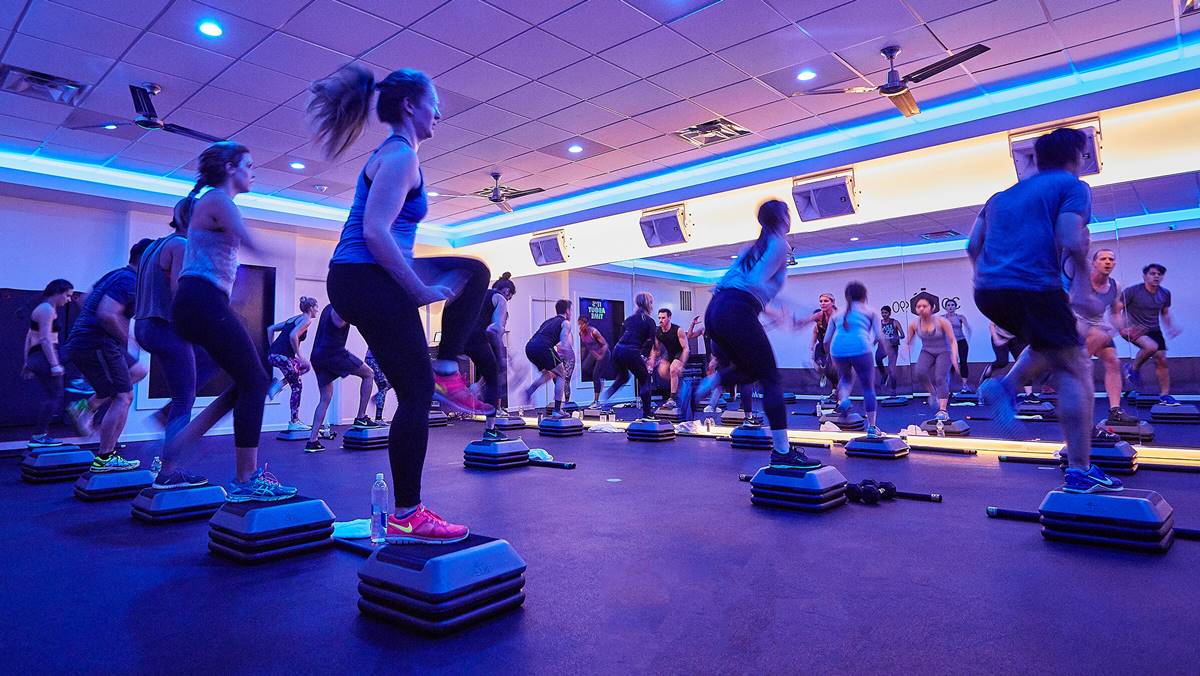Home>Misc>Featured>What Are The Two Types Of Interval Training


Featured
What Are The Two Types Of Interval Training
Modified: August 21, 2023
Discover the two types of interval training and how they can help you achieve your fitness goals. Don't miss out on this featured article!
Introduction
Interval training has become a popular and effective method of improving fitness levels and achieving weight loss goals. This training technique involves alternating between periods of high-intensity exercise and periods of rest or lower-intensity exercise. By challenging the body with intense bursts of activity, interval training can provide numerous benefits that traditional steady-state cardio workouts may not offer.
Interval training is highly customizable and can be adapted to fit different fitness levels and goals. Whether you’re a seasoned athlete looking to improve performance or a beginner seeking to boost overall fitness, interval training can help you reach your objectives more efficiently.
One of the key factors that sets interval training apart from conventional exercise is the element of intensity. The explosive bursts of high-intensity exercise push the body to its limits, maximizing the number of calories burned and increasing cardiovascular endurance. These intense intervals are alternated with periods of active recovery, allowing the body to recuperate before the next high-intensity push.
Unlike steady-state cardio workouts, where you maintain a consistent pace for an extended period, interval training keeps your body guessing and prevents it from hitting a plateau. By constantly challenging your muscles and cardiovascular system, interval training promotes continuous improvement and stimulates both fat loss and muscle growth.
In the following sections, we will explore the two primary types of interval training: High-Intensity Interval Training (HIIT) and Low-Intensity Steady State (LISS) Interval Training. We will delve into the unique benefits of each type and discuss how you can incorporate interval training into your fitness routine to maximize your results.
Definition of Interval Training
Interval training is a form of exercise that involves alternating between periods of high-intensity activity and periods of rest or lower-intensity exercise. It is a structured training method that aims to improve cardiovascular fitness, maximize calorie burn, and enhance overall athletic performance.
The fundamental principle of interval training is the concept of intervals, which refers to the specific duration of the high-intensity and rest periods. The length and intensity of these intervals can vary depending on the fitness level and goals of the individual.
During the high-intensity intervals, individuals push themselves to their maximum effort, engaging in activities such as sprinting, jumping, or performing high-intensity exercises. This high-intensity phase typically lasts for a shorter duration, usually ranging from 20 seconds to several minutes, depending on the fitness level and workout structure.
After the high-intensity phase, a period of rest or lower-intensity exercise follows. This allows the body to recover and prepares it for the next set of high-intensity intervals. The rest periods can vary in length, typically ranging from a few seconds to a few minutes, depending on the individual’s fitness level and training program.
Interval training can be performed with various exercise modalities, including running, cycling, swimming, circuit training, and even bodyweight exercises. The key is to alternate between periods of intense exertion and active recovery to challenge the body and stimulate physiological adaptations.
This type of training is highly versatile and adaptable, making it suitable for individuals of different fitness levels and goals. It can be adjusted to accommodate beginners who may need longer rest periods or lower intensities, as well as advanced athletes who can handle shorter rest periods and higher intensities.
Interval training is commonly used in both cardiovascular and strength training routines. It can enhance aerobic capacity, increase anaerobic power, improve muscular endurance, and promote weight loss by boosting metabolism.
In the next sections, we will explore the two main types of interval training and delve into their specific benefits and characteristics.
The Benefits of Interval Training
Interval training offers a wide range of benefits that make it an attractive and effective exercise method for individuals of all fitness levels. Let’s explore some of the key advantages:
1. Efficient calorie burning: Interval training is highly effective for burning calories and promoting weight loss. The intense bursts of activity during high-intensity intervals elevate the heart rate and increase metabolic rate, leading to a higher number of calories burned during and after the workout. This phenomenon, known as excess post-exercise oxygen consumption (EPOC), allows the body to continue burning calories even after the exercise session ends.
2. Time-saving: Interval training can be a time-efficient option for those with busy schedules. The combination of high-intensity intervals and shorter rest periods allows you to achieve a challenging and effective workout in a shorter amount of time compared to traditional cardio exercises like steady-state running or cycling.
3. Cardiovascular benefits: Interval training greatly improves cardiovascular fitness. The intense intervals elevate heart rate and challenge the cardiovascular system, leading to increased cardiac output, improved oxygen utilization, and enhanced overall cardiovascular endurance. This can have a positive impact on heart health and reduce the risk of cardiovascular diseases.
4. Metabolic boost: Interval training has been shown to increase metabolic rate and improve insulin sensitivity. The intense exercise stimulates muscle growth and the release of hormones, such as human growth hormone (HGH), which optimize metabolism and promote fat burning. This can be beneficial for weight management and improving body composition.
5. Variety and reduced boredom: Interval training offers endless possibilities for workout variation, allowing you to mix different exercises and intensities. This variety prevents monotony and keeps you engaged and motivated to stick with your fitness routine long-term.
6. Adaptability and scalability: Interval training can be adapted to different fitness levels and goals. Whether you are a beginner or an advanced athlete, the duration and intensity of the intervals can be adjusted to suit your current fitness level. This makes interval training accessible and challenging for everyone.
7. Improved anaerobic capacity: The high-intensity intervals in interval training improve anaerobic capacity, which is the ability to perform intense bursts of activity without accumulating lactic acid or experiencing muscle fatigue. This can enhance performance in sports that require quick bursts of speed and power.
8. Preservation of muscle mass: Unlike long-duration, low-intensity cardio exercises, interval training helps preserve muscle mass. The high-intensity intervals stimulate muscle growth and increase muscle fiber recruitment, which is crucial for maintaining muscle strength and preventing muscle loss.
Incorporating interval training into your fitness routine can provide you with these diverse benefits and help you achieve your fitness goals more efficiently. In the following sections, we will explore the two main types of interval training: High-Intensity Interval Training (HIIT) and Low-Intensity Steady State (LISS) Interval Training.
Type 1: High-Intensity Interval Training (HIIT)
High-Intensity Interval Training (HIIT) is a type of interval training that involves short, intense bursts of exercise followed by brief recovery periods. This form of training pushes your body to its limits with maximum effort and offers a multitude of benefits:
1. Increased calorie burn: HIIT is known for its ability to torch calories. The high-intensity intervals elevate your heart rate significantly, leading to a higher calorie expenditure compared to traditional steady-state cardio exercises. Research has shown that HIIT can help burn more calories in less time, making it an efficient method for weight loss.
2. Enhanced cardiovascular fitness: HIIT improves cardiovascular endurance by challenging the heart and lungs to work at a high intensity. This type of training increases your aerobic capacity, allowing you to perform better during intense activities and recover more effectively afterwards.
3. Time-efficiency: HIIT workouts are typically shorter in duration compared to steady-state cardio sessions. The intense nature of HIIT enables you to achieve a highly effective workout in a shorter amount of time, making it ideal for those with busy schedules.
4. Increased fat burning: HIIT promotes fat burning by stimulating the release of hormones that mobilize stored fat for energy. The intense intervals create an oxygen debt, forcing your body to burn fat during the recovery periods to restore oxygen levels.
5. Muscle preservation and development: While HIIT primarily focuses on cardiovascular fitness, it also stimulates muscle growth and development. The high-intensity intervals activate fast-twitch muscle fibers, promoting muscle strength and preserving lean muscle mass.
6. Boosted metabolism: HIIT has been shown to have a long-lasting impact on metabolism. The intense workouts increase your metabolic rate, leading to continued calorie burn even after the exercise session has ended. This can contribute to weight loss and weight maintenance in the long term.
7. Versatility: HIIT can be adapted to various forms of exercise, such as running, cycling, bodyweight exercises, and high-intensity circuit training. This versatility allows you to choose the activities that align with your preferences and fitness goals, while still reaping the benefits of high-intensity interval training.
When conducting a HIIT workout, it is essential to maintain proper form and technique to minimize the risk of injury. Because of the intensity involved, it is recommended to start with shorter intervals at a lower intensity and gradually progress as your fitness level improves.
Incorporating HIIT into your fitness routine can be done through structured workouts or by incorporating high-intensity intervals into your existing workouts. For example, you can perform a 20-second sprint followed by a 10-second recovery and repeat this cycle for a total of 10 minutes. Remember to warm up properly before starting a HIIT session and cool down afterwards to aid in recovery.
Now that we have explored the benefits of HIIT, let’s move on to discussing the second type of interval training, Low-Intensity Steady State (LISS) Interval Training.
Type 2: Low-Intensity Steady State (LISS) Interval Training
Low-Intensity Steady State (LISS) Interval Training is another form of interval training that involves prolonged periods of low-intensity exercise. Unlike High-Intensity Interval Training (HIIT), LISS training focuses on maintaining a steady and moderate pace throughout the workout. Here are some key characteristics and benefits of LISS training:
1. Longer duration: LISS workouts typically last for a longer duration compared to HIIT workouts. The extended exercise period allows you to engage in continuous low-intensity activity, such as walking, cycling, swimming, or using an elliptical machine.
2. Sustainable intensity: LISS training is performed at a moderate intensity that can be sustained comfortably for an extended period without causing excessive fatigue or breathlessness. This makes it an ideal option for individuals who are new to exercise or those who prefer a less intense workout.
3. Increased fat oxidation: LISS training primarily relies on fat as the main energy source. When performing low-intensity exercise for an extended duration, your body taps into stored fat as fuel, promoting fat oxidation and potentially aiding in weight loss.
4. Muscle recovery and active rest: LISS training can be utilized as active recovery between more intense workouts. By engaging in low-intensity exercise on rest days or after intense training sessions, you promote blood circulation, aid in muscle recovery, and prevent muscle soreness.
5. Reduced stress on joints: Due to the low-impact nature of LISS exercises, such as walking or cycling, there is less stress placed on the joints compared to high-impact activities. This makes LISS training a suitable option for individuals with joint pain or those recovering from injuries.
6. Improved endurance: LISS training helps improve cardiovascular endurance by conditioning the heart and lungs over an extended period. It enhances the efficiency of oxygen utilization and strengthens the cardiovascular system, leading to increased endurance and improved overall fitness.
7. Versatility and accessibility: LISS training can be performed in various settings and with different exercise modalities. Whether you prefer outdoor activities like walking or jogging, indoor cycling, or using cardio machines at the gym, LISS training offers flexibility and accessibility for individuals of all fitness levels.
When incorporating LISS training into your fitness routine, it is important to maintain a consistent pace and intensity throughout the workout. Aim for a duration of 30 to 60 minutes, or even longer if you have the time and energy.
LISS training can be a great option for active recovery, endurance training, or simply as a low-impact form of exercise to improve cardiovascular health. It is important to note that while LISS training may not provide the same immediate calorie burn as HIIT, it can still contribute to overall calorie expenditure and support weight management goals.
Now that we have explored the benefits and characteristics of both HIIT and LISS training, let’s compare these two types of interval training and discuss how you can incorporate them into your fitness routine.
Comparing HIIT and LISS Interval Training
High-Intensity Interval Training (HIIT) and Low-Intensity Steady State (LISS) Interval Training are two distinct types of interval training that offer unique benefits and cater to different fitness goals. Let’s compare these two training methods:
1. Intensity and effort: The most notable difference between HIIT and LISS training is the intensity level. HIIT involves short bursts of high-intensity exercise, pushing your body to its limits. On the other hand, LISS training is performed at a moderate intensity that can be comfortably maintained for an extended period.
2. Calorie burn: HIIT workouts are known for their high calorie burn due to the intense nature of the intervals. The elevated heart rate and metabolic demands during HIIT can lead to a greater overall calorie expenditure compared to LISS training. However, LISS training contributes to calorie burn as well, especially when performed for a longer duration.
3. Cardiovascular fitness: Both HIIT and LISS training improve cardiovascular health and endurance. HIIT places a greater emphasis on anaerobic capacity and explosiveness, while LISS training focuses on steady aerobic conditioning. Depending on your goals, you can choose the training method that aligns with your preferences and fitness objectives.
4. Muscle development: HIIT workouts engage fast-twitch muscle fibers and stimulate muscle growth and strength. This makes HIIT training effective for building lean muscle mass. LISS training, while not as muscle-focused, still contributes to muscle preservation and toning due to the sustained exercise duration.
5. Time efficiency: HIIT training is a time-efficient option for those with limited time for workouts. The shorter duration of intense intervals followed by brief rest periods allows for a highly effective workout in a shorter amount of time. LISS training, on the other hand, requires a longer duration to achieve similar calorie burn and cardiovascular benefits.
6. Adaptability: Both HIIT and LISS training can be adapted to suit different fitness levels and preferences. HIIT can be adjusted by modifying the interval duration and intensity, making it accessible to beginners and challenging for advanced athletes. LISS training can be customized by varying exercise modalities and intensities to cater to individual preferences and limitations.
Ultimately, the choice between HIIT and LISS training depends on your fitness goals, preferences, and individual needs. If you are looking for a time-efficient and intense workout that maximizes calorie burn and improves anaerobic capacity, HIIT may be the ideal choice. On the other hand, if you prefer a moderate-intensity, steady-paced workout that enhances cardiovascular endurance and allows for active recovery, LISS training may be more suitable.
It is also worth noting that a combination of HIIT and LISS training can be incorporated into your fitness routine for optimal results. This approach allows for variety, prevents plateaus, and caters to different energy systems within the body.
In the next section, let’s explore how you can incorporate interval training, whether it’s HIIT, LISS, or a combination of both, into your fitness routine to achieve your desired fitness goals.
How to Incorporate Interval Training into Your Fitness Routine
Incorporating interval training into your fitness routine can bring a new level of effectiveness and excitement to your workouts. Whether you choose High-Intensity Interval Training (HIIT) or Low-Intensity Steady State (LISS) Interval Training, here are some tips on how to integrate interval training into your exercise regimen:
1. Determine your fitness goals: Before incorporating interval training, it’s important to identify your fitness goals. Whether you want to improve cardiovascular endurance, lose weight, increase muscle strength, or enhance overall fitness, understanding your objectives will help guide your interval training approach.
2. Choose the right type of interval training: Decide whether HIIT or LISS training aligns better with your goals, preferences, and current fitness level. If you enjoy intense, short bursts of activity and have a solid fitness foundation, HIIT might be a good fit. If you prefer longer durations of moderate-intensity exercise or need low-impact options, LISS training can be more suitable.
3. Set a schedule: Determine how often you want to incorporate interval training into your routine. Start with one or two sessions per week and gradually increase the frequency as your body adapts and becomes more conditioned. Remember to allow for adequate rest days to prevent overtraining and promote recovery.
4. Select suitable exercises: Choose exercises that are appropriate for your fitness level and align with your goals. For HIIT, opt for explosive movements such as sprints, burpees, jump squats, or kettlebell swings. For LISS, activities like brisk walking, cycling, swimming, or using cardio machines at a moderate intensity are ideal.
5. Warm up properly: Before starting your interval training session, warm up for 5-10 minutes with dynamic stretches and light to moderate intensity cardio. This will increase blood flow to the muscles, prepare the body for exercise, and reduce the risk of injury.
6. Structure your intervals: Determine the duration and intensity of your intervals based on your fitness level and goals. For HIIT, aim for short bursts of high intensity followed by shorter recovery periods. For LISS, maintain a steady pace at a moderate intensity throughout the duration of the workout.
7. Progress gradually: Gradually increase the intensity, duration, or frequency of your intervals over time as your fitness level improves. This gradual progression will help prevent injury and allow for continued adaptation and improvement.
8. Cool down and stretch: After completing your interval training session, cool down with 5-10 minutes of light cardio followed by static stretching. This will help lower your heart rate, promote circulation, and aid in muscle recovery and flexibility.
9. Mix and match: Don’t be afraid to mix and match interval training methods to keep your workouts varied and challenging. You can incorporate both HIIT and LISS workouts into your routine to target different energy systems, prevent plateaus, and maintain motivation.
10. Listen to your body: Pay attention to how your body feels during and after interval training sessions. Push yourself, but know your limits and adjust the intensity or duration as needed. It’s important to find a balance between pushing yourself and avoiding overexertion.
By incorporating interval training into your fitness routine, you can maximize your workout efficiency, improve cardiovascular fitness, burn calories, and reach your fitness goals more effectively. Remember to consult with a healthcare professional or fitness expert if you have any underlying health concerns or are new to interval training.
Now that you have a solid understanding of how to incorporate interval training, you can begin implementing these techniques into your workouts and experience the benefits firsthand.
Conclusion:
Interval training, whether in the form of High-Intensity Interval Training (HIIT) or Low-Intensity Steady State (LISS) training, offers numerous benefits for improving fitness levels and achieving various fitness goals. By incorporating interval training into your fitness routine, you can maximize calorie burn, improve cardiovascular endurance, enhance muscle strength, and boost overall fitness.
HIIT, with its intense bursts of activity followed by short recovery periods, is ideal for those seeking a high-intensity, time-efficient workout that pushes the limits of their fitness capabilities. On the other hand, LISS training focuses on sustained, moderate-intensity exercise over a longer duration, making it suitable for individuals looking for a steady, less intense workout or active recovery.
Regardless of the type of interval training you choose, it is important to listen to your body, gradually progress, and maintain proper form and technique to prevent injury. By setting clear goals, selecting suitable exercises, and incorporating interval training into your routine, you can experience the many benefits that interval training has to offer.
Remember, interval training allows for versatility and customization. You can adjust the duration, intensity, and frequency of intervals based on your fitness level, preference, and goals. It’s all about finding the right balance and challenging yourself while still enjoying the process.
Incorporating interval training into your fitness routine can bring excitement, variety, and efficiency to your workouts. Whether you’re striving to improve cardiovascular fitness, lose weight, build muscle, or enhance overall well-being, interval training can help you achieve your goals in a time-effective and enjoyable manner.
So, take the first step and start integrating interval training into your fitness routine today. Embrace the challenge, celebrate the progress, and enjoy the rewards that come with pushing your boundaries and achieving new levels of fitness.









